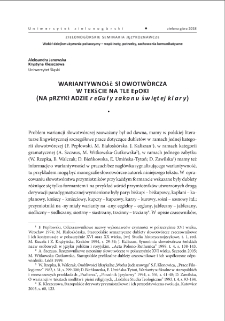Digital Library of Zielona Góra contains 9 283 digital objects
Object
Title: Wariantywność słowotwórcza w tekście na tle epoki (na przykładzie "Reguły zakonu świętej Klary") = Word-formative variance of a text in the context of the period (on the basis of the example of the "Rule of St. Clare")
Contributor:
Hawrysz, Magdalena - red. nauk. ; Uździcka, Marzanna - red. nauk.
Group publication title:
Abstract_pl:
Artykuł stanowi propozycję opisu zabytków językowych pod względem zachowawczości bądź postępowości użytych w nich dubletów słowotwórczych, a tym samym badania charakteru tekstu: jego progresywności lub regresywności na tle epoki, w której powstał. O charakterze tym można mówić dzięki porównaniu z jednej strony z językiem epoki wcześniejszej, z drugiej - ze stanem współczesnym. ; Analizie poddano szesnastowieczną "Regułę zakonu świętej Klary". Badania wykazują, że nie sposób jednoznacznie ocenić zabytek. Jednak mimo pewnych zastrzeżeń opisane wybory wariantów słowotwórczych pozwalają na stwierdzenie, że język "Reguły zakonu świętej Klary" cechuje postępowość, tekst dobrze wpisuje się w linię rozwojową polszczyzny.
Abstract:
The article constitutes a proposition related to a description of the linguistic monuments in the context of conservativity or progressivity of the word-formative doublets which are used in them, and thus to study the nature of the text: its progressivity or regressivity against the background of the period in which the text arose. We may discuss this nature owing to, on the one hand, a comparison with the language of the previous period and on the other hand, a comparison with the contemporary state of affairs. ; The sixteenth-century "Rule of St. Clare" was subject to an analysis. Research indicates that it is impossible to evaluate the monument in an unambiguous manner. However, despite certain reservations the choices of word-formative variants which were described enable us to state that the language of the "Rule of St. Clare" is characterised by progressivity; the text fits the line of the development of the Polish language very well.
Publisher:
Zielona Góra: Oficyna Wydawnicza Uniwersytetu Zielonogórskiego
Format:
Resource Identifier:
Pages:
Source:
Zielonogórskie Seminaria Językoznawcze 2017
Language:
Rights:
Biblioteka Uniwersytetu Zielonogórskiego
Object collections:
- Repository > Faculties > Faculty of Humanities
- Repository > Types of work > Articles
- Repository > Scientific journals and UZ publishing series > Zielonogórskie Seminaria Językoznawcze
Last modified:
Jan 25, 2024
In our library since:
Jan 25, 2024
Number of object content hits:
129
All available object's versions:
https://zbc.uz.zgora.pl/repozytorium/publication/86795
Show description in RDF format:
Show description in OAI-PMH format:
Objects Similar
Mazur, Magdalena Kataryńczuk-Mania, Lidia - red. nauk.

